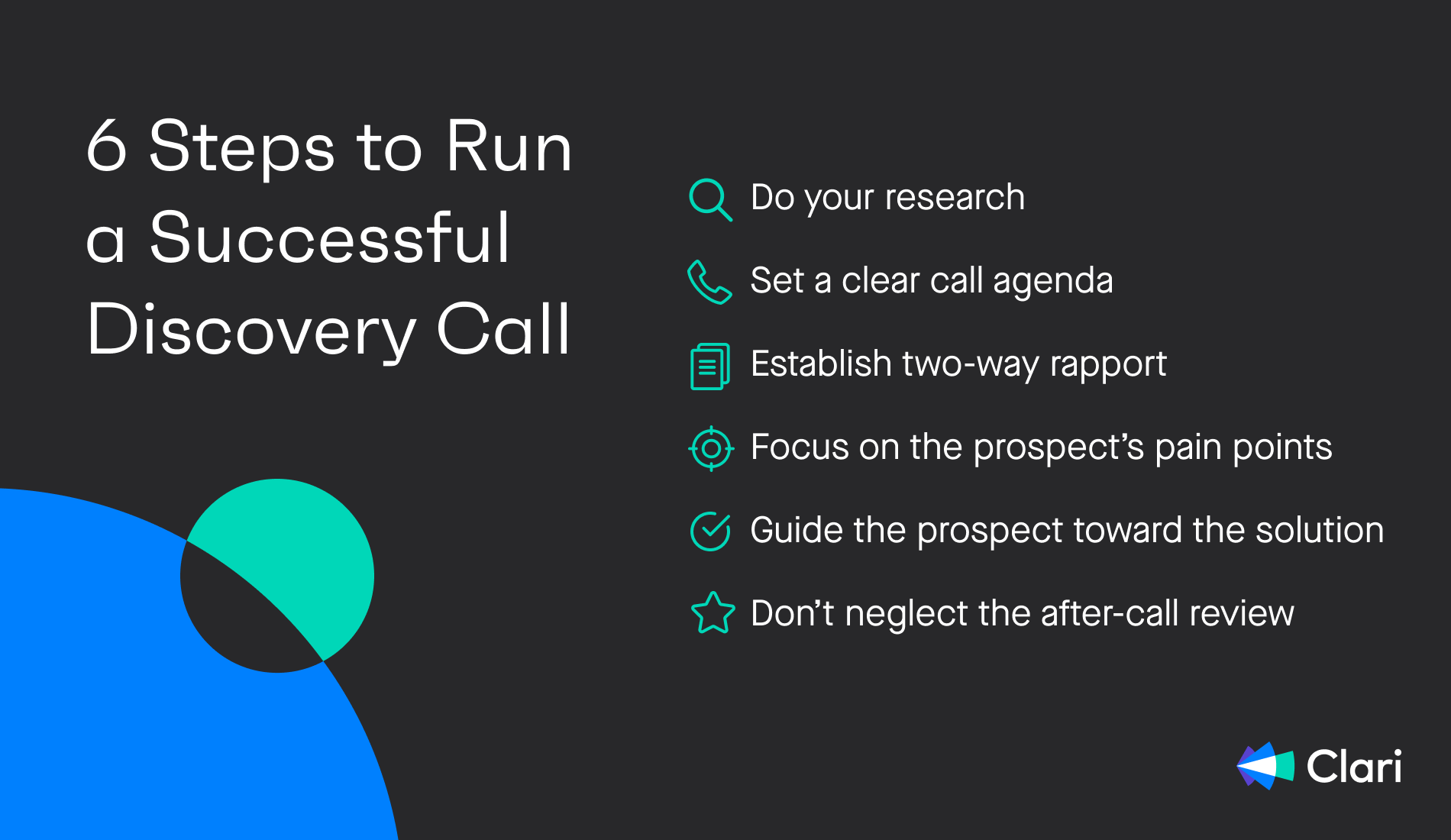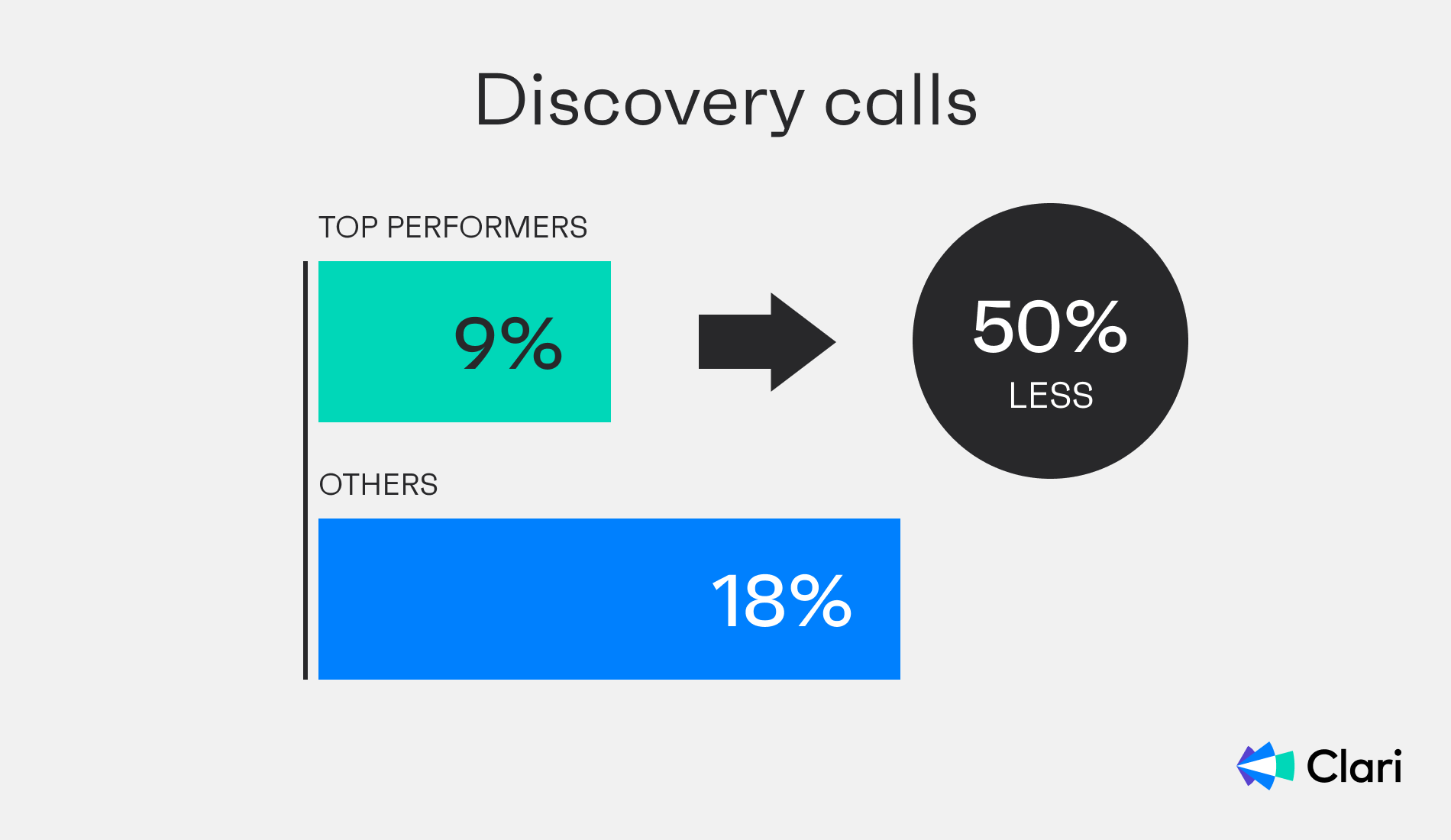In sales, success hinges on mastering pivotal moments. The discovery call is the turning point where potential transforms into a tangible sales opportunity.
In this article, we're getting straight to the point, highlighting the central role of the discovery call in the sales process and giving you everything you need to know to successfully navigate one.
We’ll unpack the significance of the discovery call, map out the route to success, and equip you with a tactical arsenal of example questions you can use. Let’s dive in.
Table of Contents
- What is a discovery call?
- What makes a discovery call so important
- 6 steps to run a successful discovery call
- The do’s and don'ts of discovery calls
- Discovery call questions to ask every prospect
- What's next?
What is a discovery call?
A discovery call is a pivotal initial conversation in sales. During it, a representative engages with a potential client to understand their needs and introduce the company's services. The primary goal of this call is to identify high-quality prospects and determine if there is a potential match. If so, the aim is to move them further down the sales pipeline.
During the call, the representative focuses on two main objectives: comprehending the prospect's challenges and goals and allowing the prospect to gain insights into what the company offers. This dual approach helps assess whether the prospect is a good fit for the company's solutions and sets the stage for a successful and mutually beneficial business relationship.
The discovery call is thus a critical step that initiates a give-and-take dynamic, fostering a strong, understanding relationship between the sales representative and the prospect. Through this interaction, the representative can effectively guide potential clients toward a deeper engagement with the company's products or services — ultimately increasing the likelihood of successful conversions.
What makes a discovery call so important
Discovery calls act as the first step in establishing successful client relationships. These calls are not just preliminary chats but are key to understanding client needs and setting the foundation for future interactions.
Here are the key benefits of discovery calls for international businesses:
Identify qualified leads
Discovery calls help businesses identify which leads have the highest potential to become customers. This prioritization ensures that efforts are concentrated on the most promising opportunities.
By understanding which prospects are genuinely interested and have needs that align with the business’s offerings, resources can be allocated more efficiently, optimizing the sales process.
Get a better understanding of your customers
Discovery calls provide deep insights into clients’ specific challenges and objectives.
Understanding clients' specific requirements through discovery calls leads to more effective engagement, as interactions are based on a solid understanding of their needs and expectations.
Fine-tune your sales strategy
Armed with the insights from discovery calls, you can develop fine-tuned sales strategies to each client's context and needs, making the approach more relevant and impactful.
6 steps to run a successful discovery call
Here’s how you can run a successful discovery call in 6 easy steps.

Step 1: Do your research
Before initiating contact, it's imperative to thoroughly research your point of contact and their business.
Gather comprehensive information about your prospect's industry, company size, and challenges. Utilize tools like LinkedIn, company websites, and industry reports. If you're calling a small e-commerce business, understanding their market positioning and competitors can provide valuable insights.
This step will help you prepare to qualify your leads and prepare for the next steps of the process.
Step 2: Set a clear call agenda
In this step, you prepare to guide the prospect throughout the call.
Start the call with a brief and friendly introduction of yourself and your role. This introduction sets a welcoming tone for the conversation and lets the prospect get to know you better from the start.
It's crucial to articulate the purpose and objectives of the call clearly. This informs the prospect about what to expect and aligns their expectations with the goals of the conversation.
Step 3: Establish a two-way rapport
Remember, while qualifying the prospect, they also assess you. Building a genuine rapport through a two-way conversation is key to successful discovery calls.
Here are some techniques you can use for building rapport:
- Use open-ended questions: Encourage sharing through questions like "What challenges are you facing?" or "What are your goals for this year?”
- Demonstrate empathy and active listening: Show genuine care and understanding. Reflect and acknowledge their concerns, e.g., "It seems like these challenges are quite frustrating for you."
- Utilize positive affirmations: Use affirming statements like "That's a great point" to validate the prospect's thoughts and opinions.
A recent study shows that customers speak during 57% of the conversation in successful discovery calls. Encourage your prospect to talk more by asking the right questions, which helps understand their needs better. We will go into more detail on this topic below.
Step 4: Focus on the prospect’s pain points
This stage requires a profound understanding of the challenges the prospect is facing, empathetic engagement, and the ability to align those challenges with your solutions effectively.
You can achieve this by asking the right questions, focusing on topics such as:
- What specific issues are you currently encountering in your operations or processes?
- Are there any recurring problems that you find particularly challenging to overcome?
- Can you describe any pain points that have been a persistent concern for your team?
Once you've identified the challenges, the next step is to investigate how they affect their daily operations and long-term goals. This involves probing further to understand the implications and consequences of these challenges.
Some relevant questions might include:
- How do these challenges impact your team's productivity and efficiency?
- How do these challenges affect your ability to meet your strategic objectives?
- Have there been any financial implications or missed opportunities due to these challenges?
By exploring the impact, you gain a comprehensive understanding of the challenges and help the prospect recognize the urgency of finding a solution.
Step 5: Guide the prospect toward the solution
Mastering the art of presenting your solution is critical to the discovery call. This step involves showcasing your product or service in a way that resonates with the prospect's unique needs and challenges.
Here are a few pitching tips to consider:
- Reiterate their challenges and demonstrate how your solution specifically addresses these.
- Remember that top performers discuss product features in only about 9% of their pitch, focusing instead on the value and benefits.
- Incorporate case studies or testimonials that resonate with the prospect’s industry.
- Conclude with a specific next step, guiding the prospect toward a decision.
This personalized approach ensures your solution is presented effectively, addressing the prospect's needs and paving the way for a successful partnership.

Step 6: Don’t neglect the after-call review
An often overlooked but crucial step is reviewing the call. This involves analyzing the conversation, what went well, and areas for improvement. Reflect on the questions asked, the responses received, and the overall flow of the conversation.
Use our Discovery Call Scorecard to objectively assess the call's effectiveness.

In the fast-paced sales world, where first impressions matter greatly, mastering discovery calls is non-negotiable.
These six essential steps, from research to post-call reviews, serve as your roadmap to success. They enable you to build trust, identify pain points, and effectively present solutions, ensuring your prospect's journey from potential client to satisfied customer is as smooth as possible.
The do’s and don'ts of discovery calls
You now know how to run successful discovery calls and their importance. So let’s recap with some do’s and don’ts of discovery calls you should remember.
Do’s of discovery calls
A successful discovery call is built on a foundation of effective communication and rapport-building. Here are some tips to ensure a smooth and productive discovery call:
- Listen attentively to the prospect's responses. Show genuine interest in their challenges and goals.
- Use open-ended questions to encourage the prospect to share more about their needs and pain points. These questions often start with words like "how," "what," and "why."
- Show empathy for the prospect's situation. Understand their challenges from their perspective and convey your willingness to help.
- Tailor your approach to each prospect. Avoid a one-size-fits-all script and adapt your questions and solutions to their situation.
- Clearly articulate the value your product or service can provide. Highlight how it addresses the prospect's pain points and fulfills their needs.
- Instead of pushing your product, focus on educating the prospect. Help them understand how your solution can solve their problems.
Don’ts of discovery calls
To ensure a productive discovery call, avoiding some common pitfalls is important. Here are a few don'ts for discovery calls:
- Avoid dominating the conversation. Let the prospect speak and share their thoughts.
- Refrain from interrupting the prospect when they are speaking. Allow them to complete their thoughts before responding.
- Don't make assumptions about the prospect's needs. Always ask questions to uncover their specific challenges.
- Avoid overwhelming the prospect with too much information about your product or service. Keep it concise and relevant.
- Don't pressure the prospect into deciding the discovery call. Respect their timeline and decision-making process.
- Don't forget to follow up after the call. Send a personalized message or additional information as promised during the conversation.
By adhering to these do’s and don’ts, you can conduct discovery calls that build trust, uncover valuable insights, and set the stage for successful business relationships.
Discovery call questions to ask every prospect
Top-performing reps ask 39% more questions during the discovery call.

As you can tell, asking questions is important to the success of discovery calls. Nevertheless, this is not an interrogation process. The questions help you guide the conversation and get the prospect to the ideal conclusion — they want to learn more about your solution.
Here are a few questions to ask during the discovery call. Of course, you can adapt the questions below to fit the context and add client or industry-specific questions.
| Question | Purpose |
| What is your role in the team? | What is your role in the team? |
| How does your current process/product meet your needs? | Identify satisfaction levels and potential gaps. |
| What goal are you trying to achieve? | Align your solution with their strategic objectives. |
| What is preventing you from achieving your goals? | Pinpoint specific challenges where your solution could be beneficial. |
|
What problem are you trying to solve? |
Directly address immediate needs with your product or service. |
| Have you identified the source of your problem? | Gauge their awareness of the issue and readiness for a solution. |
| Have you looked at potential solutions? | Understand their research depth and openness to new options. |
| What would a successful outcome look like? | Visualize their desired end state, aiding in tailoring your pitch. |
|
What’s your timeline for implementing a solution? |
Assess urgency and plan your proposal accordingly. |
| How do you measure success in your role? | Align your solution with their performance metrics. |
| What’s your biggest concern about changing solutions? | Address fears or objections they might have. |
| Who else is involved in the decision-making process? | Identify key stakeholders and their roles. |
| What’s your budget for this solution? | Ensure your solution is financially feasible for them. |
| How has your team adapted to past changes or implementations? | Gauge their adaptability and readiness for a new solution. |
|
What’s the most important factor in choosing a new solution? |
Prioritize features or benefits that matter most to them. |
What's next?
The discovery call is a crucial step in your sales process that sets the foundation for a successful and targeted sales approach. In this guide, we outlined the steps you can take to ensure these calls are strategic and successful.
You don’t have to do it all manually. Clari Copilot, our sales intelligence software, has your back.
Real-time assistance during discovery calls ensures a balanced dialogue and enables you to confidently tackle objections.
Clari Copilot's conversation intelligence platform goes beyond, allowing you to revisit call transcripts in an AI-driven manner. It consolidates data from CRM and dialer, providing actionable insights in a few clicks.
Ready to elevate your approach to discovery calls? Book a demo with Clari Copilot today and experience how it can redefine success in your sales game.


